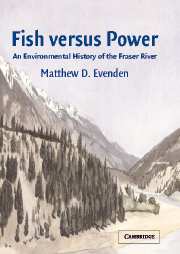Book contents
- Frontmatter
- Contents
- List of Tables, Figures, Photographs, and Maps
- List of Abbreviations
- Acknowledgments
- Introduction
- 1 “A Rock of Disappointment”
- 2 Damming the Tributaries
- 3 Remaking Hells Gate
- 4 Pent-Up Energy
- 5 The Power of Aluminum
- 6 Fish versus Power
- 7 The Politics of Science
- Conclusion
- Bibliography
- Index
1 - “A Rock of Disappointment”
Published online by Cambridge University Press: 19 August 2009
- Frontmatter
- Contents
- List of Tables, Figures, Photographs, and Maps
- List of Abbreviations
- Acknowledgments
- Introduction
- 1 “A Rock of Disappointment”
- 2 Damming the Tributaries
- 3 Remaking Hells Gate
- 4 Pent-Up Energy
- 5 The Power of Aluminum
- 6 Fish versus Power
- 7 The Politics of Science
- Conclusion
- Bibliography
- Index
Summary
Stories of the disaster always went back to the fish: pools of them, red, mature sockeye, writhing in the river, penned in and constrained. They could be seen for miles downstream. At Hells Gate in 1913, the salmon migration to the upper basin had been virtually blocked. (I have followed the BC gazetteer's spelling of Hells Gate, despite the widespread use of an apostrophe – as in Hell's Gate.) This place was a narrow passage, difficult for migration in any year. In the summer of 1913, it was worse yet because a series of landslides had changed the river's course, filled pools and eddies, and created impassable falls. The gate had practically turned into a dam. John Pease Babcock, BC's assistant commissioner of fisheries, said it was “a wonderful sight.” From 1911 to 1913, railway construction crews had triggered these slides while laying track on the river's east bank. For two years, government construction crews attempted to remove the debris. At Hells Gate, the slope continued to slide.
The scale of the Hells Gate slides and their effects are difficult to imagine. The Fraser was the most productive salmon river in the world; 1913 was one of the spectacular “big years” – when dominant runs, occurring once every four years, return to the river. The slides not only helped to destroy the big-year run of 1913, but also initiated a chain reaction in subsequent salmon runs.
- Type
- Chapter
- Information
- Fish versus PowerAn Environmental History of the Fraser River, pp. 19 - 52Publisher: Cambridge University PressPrint publication year: 2004



